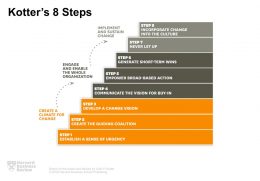 Last week, we started to look at ‘Kotter’s 8 Step Process for Leading Change’. Importantly, we touched on the need to use these steps as an overlay to a Strategic Planning Process. It’s also worth reiterating that although Kotter’s steps can appear linear, effective application often involves concurrent and parallel activity aligned with the Strategic Plan.
Last week, we started to look at ‘Kotter’s 8 Step Process for Leading Change’. Importantly, we touched on the need to use these steps as an overlay to a Strategic Planning Process. It’s also worth reiterating that although Kotter’s steps can appear linear, effective application often involves concurrent and parallel activity aligned with the Strategic Plan.

We will now look at the next 2 steps in ‘Creating a Climate for Change’ which Kotter describes as:
Step 2: ‘Create The Guiding Coalition’
Step 3: ‘Develop a Change Vision’
Step 2 – ‘Create The Guiding Coalition’

A Guiding Coalition is a group or team of people with enough influence, capability and credibility to lead a change or transformation programme. The Guiding Coalition need a common goal to work towards, they need to have trust and confidence in each other and to invest time in building relationally. Equally important, everyone else in the organisation needs to trust and have confidence that they can lead and deliver the change or transformation.
Key to the success of a Guiding Coalition is that it comprises ‘a diverse many, rather than a limited few’. Too often, groups are made up of only senior managers and leaders, many of whom are detached from the reality of what gets delivered on the ground, and even if they’re not, are likely to be perceived by many in the organisation as being disconnected. As always, perception and reality have a habit of coming together in unhelpful ways.
A key role for the Guiding Coalition is to enrol more people in the change or transformation. Pockets of urgency are likely to be alive and well right across the organisation, but unless it’s modelled from the top, engaged and harnessed, it is likely to fizzle out, resulting in a backward step rather than a delivery of change for the future. Creating opportunities for people from all areas and levels of an organisation to be part of the change process is essential, and will ensure there is sufficient critical mass to overcome the inevitable resistance in other parts.
Step 3 – ‘Develop a Change Vision’
Who develops the vision?
Vision was touched on previously and it can often be the case that the vision is created by the ‘Guiding Coalition’. While there are benefits in this approach, the reality is that a Guiding Coalition in a transformation programme may include significant numbers of people, thereby introducing very practical challenges. In the context of church or a wider ministry it is usually more appropriate for the vision to be determined by the elders or leaders to create a compelling, motivating and inspiring vision. While ‘Step 3’ is ‘Develop a Change Vision’, circumstances may determine a different sequence in which the vision is created. Dogma has no place in major change or transformation.
Clarity of vision
An effective vision should paint a bold, achievable and clear picture of the future. It should connect people at a head and heart level, be specific enough to enable effective decision-making, broad and flexible enough to cope with the inevitable changing environment and context in which it will be delivered, and it should be easy to communicate.
A vision statement itself is only one part of the ‘change vision’. For it to be meaningful, the top level strategy and accompanying initiatives need to be developed and shared to bring a vision statement to life. In the absence of a supporting story, ‘Step 4’ (Communicate the Vision for Buy-In) becomes extremely challenging as the ‘how’ is absent, and so the vision statement can appear hollow.
Next week we will begin to look at ways in which the whole church or ministry can be engaged and enabled.
